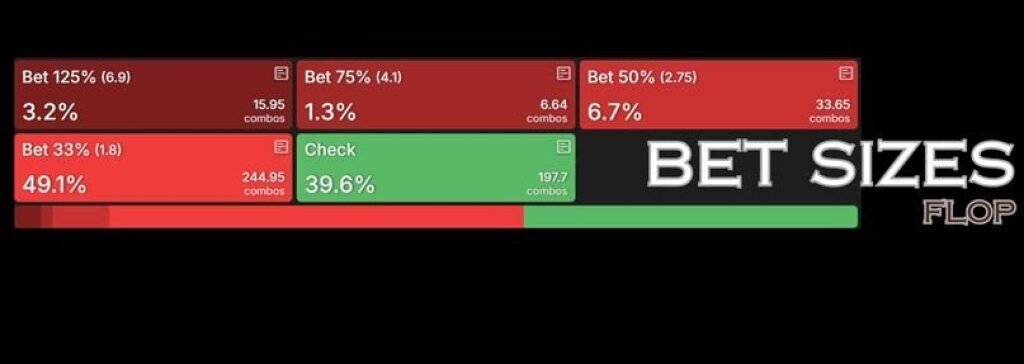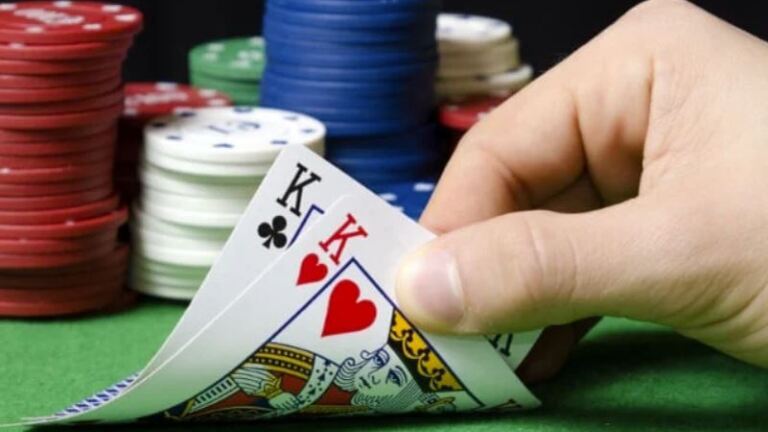In the previous articles, we discussed bet sizes preflop, going into details of open raises and isolation, 3-betting and 4-betting and last but not least how to adjust our bet sizes preflop.
Today, we’ll move on to the next street, the flop. Unlike preflop bet sizes, which are a bit more static, on the flop, we’ll have many other factors to take into account when choosing our sizings. Beginners often get lost as they try to mimic such complexity, so in today’s article, we’ll provide some principles to follow and simplify your strategy.
What is the driving factor in GTO when choosing our bet sizes?
In theory, two main factors guide the bets on the flop;
- The range advantage is responsible for frequency,
- and the nut advantage is responsible for the size.
This means that the bigger your range advantage, the more often you want to bet and the bigger your nut advantage, the bigger you want to bet. There are some well-known boards where you want to range bet for a small sizing and boards where you leverage nut advantage and introduce an overbetting strategy.
However, the case of flop bet sizes is not this simple. Due to other factors, you must consider using various sizes. It’s always a good idea to simplify, but don’t intend to mimic multiple-size GTO strategies. We suggest to have three categories in your repertoire for different purposes:
| small | 25 - 40% |
| big | 66 – 80% |
| overbet | 125%+ |
Other factors in choosing the right bet size
So what are these other factors mentioned above?
SPR – The stack-to-pot ratio. Usually, we discuss 100bb effective, cash game scenarios, but sometimes you face a short stack opponent, sit in a 200bb table, or simply find yourself in a 3-bet, 4-bet spot. No matter the case, keep in mind that SPR should affect your flop bet sizing strategy. The shallower the stacks, the smaller sizes are viable in almost any scenario.
Board texture – We have to examine the board texture, which plays a major role in who has the range and the nut advantage. This will help decide whether to bet big, often or both.
Positions and ranges that imply – However, board texture alone doesn’t tell the whole story. You must combine that texture with all the information you have. What are the positions? What was the pre-flop action? With what ranges do players arrive at the flop? Combined with board texture, these ranges will give you the complete picture of how to approach your flop strategy.
Position – in the sense of being in position or out of position. Being in a position always gives you a large variety of reasons to consider. Out of position, you’ll be forced to play more cautiously. For example, betting on a polarized range with a bigger sizing might be a good idea in most cases.
Exploitation – Adjusting to your opponent could make a whole article in itself. Right now, we’ll only highlight some ideas to consider. If you think your opponent (or the player pool) folds too much to continuation bets, then you should attack more often than the theoretically optimal frequency for a small sizing. The other side of the coin is that you don’t need to consider defending your checkback ranges if your opponents don’t capitalize on range deformation.
Examples of the correct bet sizing
When is it a good idea to bet small (25-40%)?
Range advantage gives an excellent base for small sizing. For example, in a BTN vs BB situation, on a board like A92r. BTN has the stronger top pairs, and the top of her range is hard to be outdrawn, while some hands have little to zero incentive to bet big or bet at all (like KK, K9s, etc.).
Besides that, it’s a great example of when denying equity is unimportant. This happens very often on dry boards, like a rainbow, one face card flops with no connectivity.
Another case in which it’s recommended to use small sizes is in 3-bet and 4-bet pots. There is no need to hurry to build the pot; the SPR is already low. At the same time, you don’t want to commit yourself to a vast c-bet anyway. With a 25-33% c-bet, you give yourself room while giving a hard time for your opponent.
When is it a good idea to bet big (66-80%)?
Not surprisingly, we’ll list somewhat the reasons opposite to the ones above in the small bets. Usually, we use big sizes when equity denial is essential. So when the flop is wet and connected, our value hands are very vulnerable and incentivized to bet large. You might ask why knowing how our value hands behave is important. Well, they are the key; we bet for value in most cases, the bluffs, as we often say, „just come along”.
Betting big will extract more value when you have a strong hand and, at the same time, generate more fold equity (which your bluff hands benefit from).
An example of when you should consider betting big is a BTN vs BB situation on a board like JT5 two-tone. Even strong hands like two-pairs (JT), sets (55, TT, JJ), etc. can easily be outdrawn. Any connecting card to the board is disastrous, and that’s almost half of the deck.
When is it a good idea to bet huge (125%+)?
Overbetting is a particular situation because it requires a huge nut advantage from the c-bettor. There are some classic boards and examples, mainly including an ace and a king or a queen. For instance, in a BTN vs BB situation, a flop like AK5r. BB’s strongest hand is a set of 55, while BTN has all the goods; even an AJ is a nutted hand on this board.
When overbetting, we extremely polarize our range. There are no mediocre hands in it, just the top of our range and the best bluffs. In this case, an excellent bluffing hand would be any 5x, blocking the top of BB’s continuing range.
Summary
Hopefully, by the end of this article, you will understand why flop bet sizing is more complex than the preflop play. We established that range and nut advantage are the key driving factors in choosing our bet sizes. However, there are other elements to consider, such as SPR, flop texture, positions, exploitative reasons, etc. We suggest simplifying your strategy and having three main categories for your flop bet sizes: small (25-40%), big (66-80%) and large (125%+), as we listed in our examples.
Feel free to comment if you have any questions or want to add your opinion!
Good luck at the tables!

















0 comments